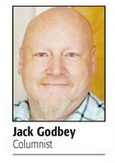People are the real story
Published 5:45 pm Friday, March 1, 2019
By MIMI BECKER
Coffee with Mimi
Historians are quite something; they are people who know more than just a collection of facts. Historians are people who can create a compelling story out of pieces of information and then place them in context. They are usually so in command of the facts and their collective place, they can stand in front of an audience for extended periods of time, without notes, to tell the story.
The really good historians are also entertaining and preferably have a sense of humor. It’s a good thing, otherwise no one in this technological age would listen. An awful lot of historical context in the age of digital information must be conveyed in 140 characters or less. If it needs another page, it had better be good stuff to hold you to the device.
My favorite historical stories are biographies — people are the star of the story. Every event is shaped by the people. While I enjoy autobiographies, they are less satisfying in the historical sense, than a good hard look at an individual from the outside
My current reading material is a biography of Florence Harding, wife of the 29th president who only served 881 days in office, which is less than 2 ½ years; he died in 1923. She lived only one year longer, to 64 years old.
For many students of history, the wife of one of the shortest serving presidents wouldn’t be much more than a footnote on her own. Even more so if you consider the character and administration of her president husband, that consumed a lot of oxygen in the atmosphere.
This story of Florence Harding is 543 pages of text, plus 183 pages of sources and notes and 16 pages of photographs, which are the usual lifeless portrait poses of the turn of the century. In this case, pictures do not tell the story.
You might think the majority of the ink is devoted to the historically significant person with whom Florence was associated. If he hadn’t been president, Florence would not have rated a biography of her own in the first place.
Sure, he was quite a case. If you want to know about that, you will get a healthy dose of material to digest within the 543 pages. But, this story belongs to Florence, start to finish. Just consider that she lived in an age when, until the election of her husband, no woman had been permitted to vote for her husband as president.
So, if it wasn’t Warren’s life as the main story, what fascinated this historian to delve into this woman’s life? Most first ladies get their own biography at some point, but 543 pages? And the type is not large.
She was a determined and willful child who grew to be a determined and willful woman in a world controlled by men. She made her way financially on her own, first as a music teacher, then as the real power and brains behind the newspaper business of her husband.
Florence was a student of the issues of the time. Despite his personal habits in their marriage, to the contrary, Warren relied on Florence to guide his career. She saw the handwriting on the wall, but used it to her own advantage. After a sketchy first marriage and divorce, life was difficult for the single mother who had been scorned by her father, but she learned her lessons well from many sources.
Florence was a character in her own right. Some of her friends were among the most powerful and controversial women of the era — one was the owner of the Hope Diamond. She also had her detractors and those wary of her reach and presence.
In a period of social turmoil and political upheaval, her opinions were sought. They were not always popular, but they were hers and not considered inconsequential by her husband; the person with the political aspirations in the family. He rose from small town Ohio politics to the presidency of the United States in record time, even with political defeats along the way.
In this biography, it takes almost half of the book to tell the story of Florence before the couple moves to the White House, which resulted in life being loaded, complicated and overwhelming.
February has President’s Day. March is Women’s History Month. It’s going to take me that long to get through the story of Florence Harding. All things considered, I’m willing to give this complicated and generally unknown woman at least that amount of time.





